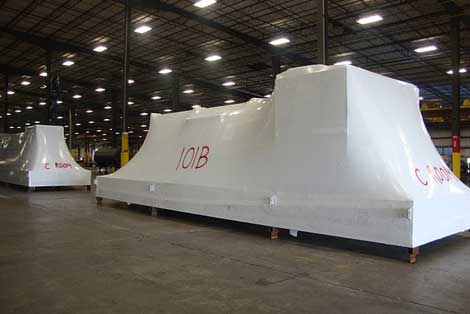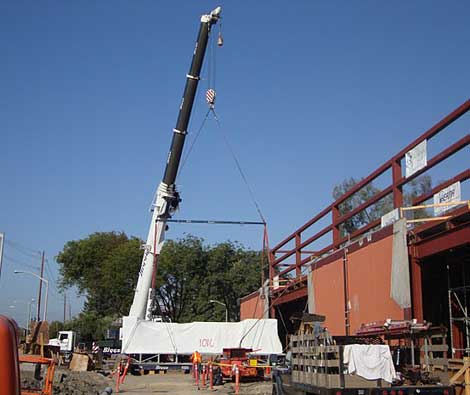
Shrink-wrapped modular power units from being delivered to the site of a Digital Realty Trust Turn-Key Datacenter project.
When it comes to the deployment of servers and storage, Digital Realty Trust doesn't expect containers to replace raised floors anytime soon. But the data center developer has long understood the potential for pre-fabricated modular components to speed the construction of electrical and mechanical infrastructure to support wholesale data center space.
That philosophy is now a core component of Digital Realty's POD Architecture 2.0, an update of its data center design that incorporates a modular approach to deploying electric room components. Digital Realty Trust says it has been building and deploying pre-fabricated power room components for more than a year, and that the new approach can cut up to two weeks off the construction timeline for its Turn-Key Datacenter product.
Digital Realty (NYSE:DLR) introduced the POD Architecture in 2009, offering a service that allowed customers to tap Digital Realty's design expertise and supply chain. From its inception, the service was envisioned as a plug-n-play approach using factory-built components that can be assembled on-site. While those pre-fab modular components weren't included in the initial rollout, Digital Realty has been deploying them since January 2010 in both Europe and North America.
'Not A Prototype'
"This construction methodology is not about producing pre-fab datacenters or containerized solutions. Nor is this a prototype," said Jim Smith, Chief Technology Officer of Digital Realty Trust. "Utilizing POD 2.0, we have already delivered 3,375 kilowatts in 2010, expect to deliver 2,250 kilowatts by early April, and have between 12 and 20 megawatts in our project pipeline in 2011. On a capital expenditure basis, this equates to $30 million of current investment and up to $100 million for 2011.
"By pre-assembling electrical and mechanical room components, while retaining the flexibility that customers require of a customized datacenter, our new POD 2.0 once again puts Digital Realty Trust customers at the forefront of datacenter development innovation," Smith said.
The centerpiece of POD Architecture 2.0 is the pre-fabrication of major electrical and mechanical systems that have traditionally been the focus for a major portion of the construction process. Digital Realty Trust has begun manufacturing, cabling and commissioning the mechanical/cooling systems and electrical systems of its Turn-Key Datacenters in a factory environment, which then are warehoused for on-time delivery to project sites. The cooling and electrical systems are pre-commissioned in the factory and then re-commissioned along with the completed datacenter.
Accelerating Data Center Construction
A key advantage to this approach is that it allows activities that previously needed to be done sequentially to be done concurrently. "When we introduced POD Architecture a few years ago, we were able to reduce the construction timeline from the traditional 24-month construction period to less than 26 weeks to deliver a data center," said Smith. "Today we have taken everything we have learned from delivering dozens of projects over the years to develop the next generation of our POD Architecture. By utilizing our POD 2.0 design, we can often deliver the datacenter ahead of the time it takes customers to build rack and cable infrastructure or have networks delivered to the new facility."
Over the past year a number of data center providers and vendors have stepped up the focus on modular architecture, both in mechanical/electrical rooms and in containers and modular data centers to house server equipment. This has accelerated the focus on pre-fab construction and modular deployment.
"Over the past decade there has been a disruption in the way data centers are planned, architected and built," said Michelle Bailey, Research Vice President for IDC's Datacenter Trends Programs. "New methodologies and blueprints have emerged that significantly shorten time to market for data center construction and result in greater levels of predictability and lower risk. Digital Realty Trust has been a leader in furthering the science of datacenter development, and POD Architecture 2.0 further integrates prefabrication and other best practices into the heart of the design and construction process."

A crane delivering a modular power unit to a Digital Realty Trust building.




